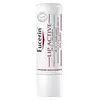What's inside
What's inside
 Key Ingredients
Key Ingredients

 Benefits
Benefits

 Concerns
Concerns

 Ingredients Side-by-side
Ingredients Side-by-side

Water
Skin ConditioningGlycerin
HumectantCetearyl Alcohol
EmollientUrea
BufferingHydrogenated Coco-Glycerides
EmollientCaprylic/Capric Triglyceride
MaskingOctyldodecanol
EmollientButyrospermum Parkii Butter
Skin ConditioningGlyceryl Stearate
EmollientCeramide NP
Skin ConditioningLactic Acid
BufferingArginine Hcl
Skin ConditioningSodium PCA
HumectantCholesterol
EmollientHelianthus Annuus Seedcake
AbrasiveAlanine
MaskingGlycine
BufferingSodium Chloride
MaskingCetyl Dimethicone
EmollientTapioca Starch
Chondrus Crispus
MaskingSodium Cetearyl Sulfate
CleansingAcrylates/C10-30 Alkyl Acrylate Crosspolymer
Emulsion StabilisingDecylene Glycol
Skin ConditioningPhenoxyethanol
PreservativePentylene Glycol
Skin ConditioningWater, Glycerin, Cetearyl Alcohol, Urea, Hydrogenated Coco-Glycerides, Caprylic/Capric Triglyceride, Octyldodecanol, Butyrospermum Parkii Butter, Glyceryl Stearate, Ceramide NP, Lactic Acid, Arginine Hcl, Sodium PCA, Cholesterol, Helianthus Annuus Seedcake, Alanine, Glycine, Sodium Chloride, Cetyl Dimethicone, Tapioca Starch, Chondrus Crispus, Sodium Cetearyl Sulfate, Acrylates/C10-30 Alkyl Acrylate Crosspolymer, Decylene Glycol, Phenoxyethanol, Pentylene Glycol
Cera Microcristallina
Emulsion StabilisingOctyldodecanol
EmollientHydrogenated Polydecene
EmollientRicinus Communis Seed Oil
MaskingCetyl Palmitate
EmollientPolyglyceryl-3 Diisostearate
EmulsifyingPanthenol
Skin ConditioningEthylhexyl Triazone
UV AbsorberButyl Methoxydibenzoylmethane
UV AbsorberCetearyl Alcohol
EmollientBis-Diglyceryl Polyacyladipate-2
EmollientMyristyl Myristate
EmollientC20-40 Alkyl Stearate
Skin ConditioningGlycerin
HumectantCopernicia Cerifera Cera
EmollientWater
Skin ConditioningTocopheryl Acetate
AntioxidantSimmondsia Chinensis Seed Oil
EmollientButyrospermum Parkii Butter
Skin ConditioningBisabolol
MaskingCera Alba
EmollientCera Microcristallina, Octyldodecanol, Hydrogenated Polydecene, Ricinus Communis Seed Oil, Cetyl Palmitate, Polyglyceryl-3 Diisostearate, Panthenol, Ethylhexyl Triazone, Butyl Methoxydibenzoylmethane, Cetearyl Alcohol, Bis-Diglyceryl Polyacyladipate-2, Myristyl Myristate, C20-40 Alkyl Stearate, Glycerin, Copernicia Cerifera Cera, Water, Tocopheryl Acetate, Simmondsia Chinensis Seed Oil, Butyrospermum Parkii Butter, Bisabolol, Cera Alba
Ingredients Explained
These ingredients are found in both products.
Ingredients higher up in an ingredient list are typically present in a larger amount.
This ingredient is also known as shea butter. It is an effective skin hydrator and emollient.
Emollients help soothe and soften your skin. It does this by creating a protective film on your skin. This barrier helps trap moisture and keeps your skin hydrated. Emollients may be effective at treating dry or itchy skin.
Shea butter is rich in antioxidants. Antioxidants help fight free-radicals, or molecules that may harm the body. It is also full of fatty acids including stearic acid and linoleic acid. These acids help replenish the skin and keep skin moisturized.
While Shea Butter has an SPF rating of about 3-4, it is not a sunscreen replacement.
Shea butter may not be fungal acne safe. We recommend speaking with a professional if you have any concerns.
Learn more about Butyrospermum Parkii ButterCetearyl alcohol is a mixture of two fatty alcohols: cetyl alcohol and stearyl alcohol. It is mainly used as an emulsifier. Emulsifiers help prevent the separation of oils and products. Due to its composition, it can also be used to thicken a product or help create foam.
Cetearyl alcohol is an emollient. Emollients help soothe and hydrate the skin by trapping moisture.
Studies show Cetearyl alcohol is non-toxic and non-irritating. The FDA allows products labeled "alcohol-free" to have fatty alcohols.
This ingredient is usually derived from plant oils such as palm, vegetable, or coconut oils. There is debate on whether this ingredient will cause acne.
Due to the fatty acid base, this ingredient may not be Malassezia folliculitis safe.
Learn more about Cetearyl AlcoholGlycerin is already naturally found in your skin. It helps moisturize and protect your skin.
A study from 2016 found glycerin to be more effective as a humectant than AHAs and hyaluronic acid.
As a humectant, it helps the skin stay hydrated by pulling moisture to your skin. The low molecular weight of glycerin allows it to pull moisture into the deeper layers of your skin.
Hydrated skin improves your skin barrier; Your skin barrier helps protect against irritants and bacteria.
Glycerin has also been found to have antimicrobial and antiviral properties. Due to these properties, glycerin is often used in wound and burn treatments.
In cosmetics, glycerin is usually derived from plants such as soybean or palm. However, it can also be sourced from animals, such as tallow or animal fat.
This ingredient is organic, colorless, odorless, and non-toxic.
Glycerin is the name for this ingredient in American English. British English uses Glycerol/Glycerine.
Learn more about GlycerinOctyldodecanol is a fatty alcohol. It is primarily used to enhance the texture of products.
As an emulsifier, Octyldodecanol helps prevent the oils and waters from separating. It also prevents ingredients from creating foam when shaken.
Octyldodecanol is created by reducing fatty acid to an alcohol.
Due to its high molecular weight, it does not get absorbed into the skin.
Learn more about OctyldodecanolWater. It's the most common cosmetic ingredient of all. You'll usually see it at the top of ingredient lists, meaning that it makes up the largest part of the product.
So why is it so popular? Water most often acts as a solvent - this means that it helps dissolve other ingredients into the formulation.
You'll also recognize water as that liquid we all need to stay alive. If you see this, drink a glass of water. Stay hydrated!
Learn more about Water